#thinkingroutines
Explore tagged Tumblr posts
Text
179: When to Get Out with Cindy and Alison
#childcare#children#daycare#earlychildhood#earlychildhoodeducation#earlylearning#ece#parenting#parents#play#teachers#thinkingroutines
0 notes
Text
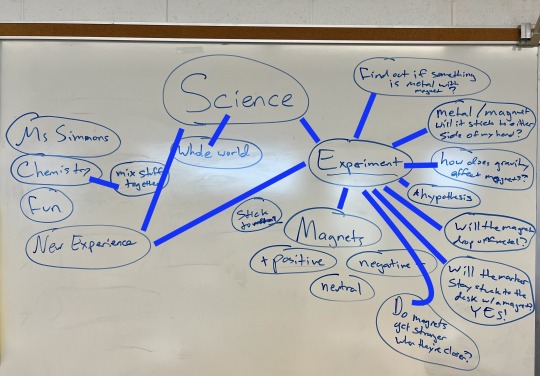
Moton Charter School
3rd Grade
Ms Simmons & Ms Chambliss
Students in Ms Simmons' and Mr Glazebrook's 3rd grade science class at Moton Charter School utilized the Generate-Sort-Connect-Extend thinking routine at the beginning of their planning process as they begin preparing to film a documentary about their science learning for the semester. In this thinking routine, students first generate as much information as they can within a large umbrella subject (in this case, "Science From This Quarter") on their own. Then we work together as a class to begin sorting that thinking into the beginnings of a concept map. As we sort student thinking, certain trends begin to emerge as connections arise between concepts that students have generated. Once we have established a few connections, students are encouraged to extend their thinking into new areas they are curious about or would like to explore further.
In this instance, you can see that many students connected to their unit on magnets and discovered connections within what magnets do. Students further built their connections between magnets and the idea of a science "experiment" and ended up extending their thinking into what they'd be curious to find out. We ended up with questions like "Does gravity affect magnets?", "Can you find out if something is metal using a magnet?", and "If I put my hand between a magnet and a piece of metal, will the magnet still stick?".
Stay tuned to see what areas of science our documentary ends up exploring!
#acting#kid smart#film#conceptmaps#thinking#thinkingroutines#science#perceiving#intuitive#MotonCharterSchool#documentary
1 note
·
View note
Photo

Teachers - this is an amazing, simple way to increase your student's thinking skills! 3-2-1 Thinking Routine http://bit.ly/32lznex
0 notes
Text
Artful Thinking #1: the “Palette”, a Set of Thinking Dispositions and Routines
Submitted by: Elisabeth Orengo, Program Intern, DC Arts and Humanities Education Collaborative
May 28, 2019
This page is the second publication of a series based on Artful Thinking: Stronger Thinking and Learning Through the Power of Art, the Artful Thinking project report, led by Principal Investigator Shari Tishman and research team members Patricia Palmer and Jessica Ross, and published in 2006. This section is dedicated to the process of art integration into curriculum. It provides an overview of a set of natural thinking dispositions that help consider the tie between art education and curriculum skills, as well as specific routines designed to enhance those inclinations.
According to the authors, who drew on the distinction between dispositions and cognitive capacities, established by Jonathan Baron in Rationality and Intelligence (1985), school curriculum traditionally values students’ “capacities factors like short term memory”, that “determine what in principle a person can do.” Moreover, students are regularly exposed to already established knowledge, and don’t experiment with the many opportunities to explore “the pattern of thinking that lead to these finished products” of thought. To offset these trends, the Artful Thinking Palette gives emphasis on the “dispositional factors (that) determine what a person does do within capacity limits.” The approach consists in encouraging students to identify the skills they use - whether during artwork exploration or other complex topics in the curriculum - and to ultimately transfer them from one context to another (p.7). Further, some routines leave students with questions, rather than answers, which is a powerful shift in understanding. As defined in Chapter 2: Artful Thinking Approach, this synergetic set of thinking dispositions is divided as follows: Questioning & Investigating, Observing & Describing, Reasoning, Exploring Viewpoints, Comparing & Connecting, Finding Complexity.
More than just strategies, thinking routines are the core of the Artful Thinking model, and an integral “part of the fabric of a classroom’s culture” that helps “students go about the process of learning.” To achieve this purpose, each routine is meant to (p. 14):
- Be oriented toward specific types of thinking
- Get used over and over again
- Consist of only a few steps
- Be easy to learn, teach, and to support when students are engaged in the routine
- Be usable across a variety of contexts, as well as by the group or by the individual
Routines are categorized by the specific thinking dispositions they individually support. A technical sheet corresponding to each item is available on the indicated pages.
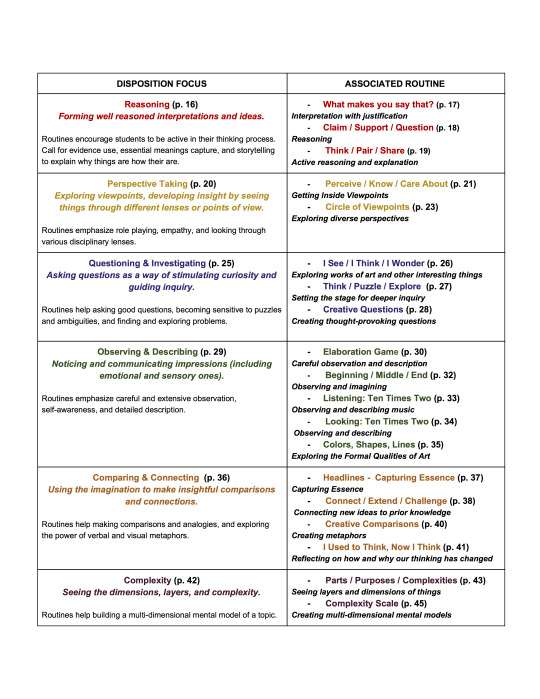
Have you ever made, or are you interested in making, use of the Artful Thinking Routines? Would you be inclined to implement them on a regular basis? Which one(s) do you feel the most confident in as tools to support your discipline and students’ needs? Please share your thoughts and comments!
0 notes
Link

Check out some free lesson templates with my 3-2-1 thinking routine - and see how my Ss communicate with their penpals in Spain! 3-2-1 Thinking Routine http://bit.ly/32lznex
3-2-1 Thinking Routine
Thinking routines are "a broad and flexible framework for enriching classroom learning...and fostering students' intellectual development at the same time."
0 notes
Photo

Teachers - this is an amazing, simple way to increase your student's thinking skills! 3-2-1 Thinking Routine http://bit.ly/32lznex
0 notes
Link

Check out some free lesson templates with my 3-2-1 thinking routine - and see how my Ss communicate with their penpals in Spain! 3-2-1 Thinking Routine http://bit.ly/32lznex
3-2-1 Thinking Routine
Thinking routines are "a broad and flexible framework for enriching classroom learning...and fostering students' intellectual development at the same time."
0 notes
Photo

Teachers - this is an amazing, simple way to increase your student's thinking skills! 3-2-1 Thinking Routine http://bit.ly/32lznex
0 notes
Link

Check out some free lesson templates with my 3-2-1 thinking routine - and see how my Ss communicate with their penpals in Spain! 3-2-1 Thinking Routine http://bit.ly/32lznex
3-2-1 Thinking Routine
Thinking routines are "a broad and flexible framework for enriching classroom learning...and fostering students' intellectual development at the same time."
0 notes
Photo
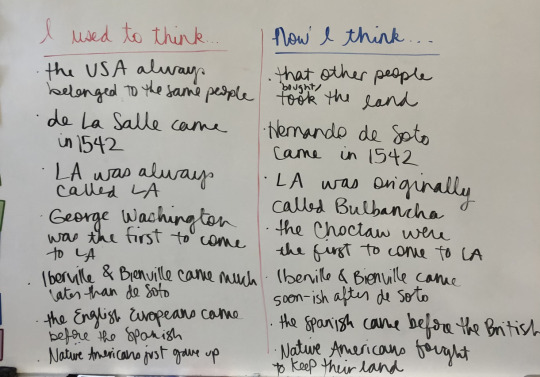
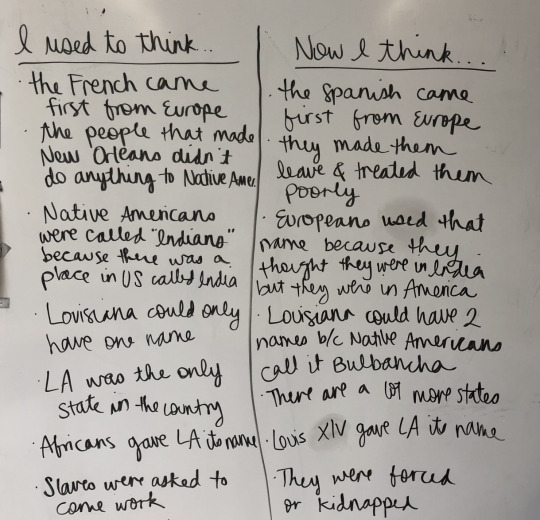
International School of Louisiana - Uptown 3rd Grade / Visual Art & Social Studies Ms. Nobile / Ms. Carbajo, Ms. Caitlin, Ms. Anne-Sophie, Ms. Alma, Ms. Guzman, Ms Geraldine
The primary focus of the third grade social studies curriculum is Louisiana. Throughout the year, students learn about our state’s geography, natural resources, history, and government. In the previous unit, students learned about the people who first inhabited this area, the Choctaw Native people. This unit covered European colonization, beginning with Hernando de Soto from Spain in 1542 and continuing with de La Salle, Iberville and Bienville from France in the 17th and 18th centuries.
The thinking routine “I used to think... / Now I think...” was developed by Project Zero as a way to “help students to reflect on their thinking about a topic or issue and explore how and why that thinking has changed. It can be useful in consolidating new learning as students identify their new understandings, opinions, and beliefs. By examining and explaining how and why their thinking has changed, students are developing their reasoning abilities and recognizing causal relationships.”
As we concluded this unit, I was so thrilled to see students’ responses to this thinking routine. Their responses are evidence of their deep learning about the history of European colonization, its impact on the native people that lived here before, and how it formed the Louisiana we know today.
Here are a few:
“I used to think the USA always belonged to the same people. Now I think that other people bought and took the land.”
“I used to think George Washington was the first to come to Louisiana. Now I think the Choctaw were the first to come to Louisiana.”
“I used to think Native Americans just gave up. Now I think Native Americans fought to keep their land.”
“I used to think Native Americans were called ‘Indians” because there was a place in the US called India. Now I think Europeans used that name because they thought they were in India, but they were in America.”
“I used to think Louisiana could only have one name. Now I think Louisiana could have two names because Native Americans called it Bulbancha.”
#thirdgrade#iusedtothink#nowithink#projectzero#thinkingroutines#makingthinkingvisible#internationalschooloflouisiana#socialstudies#nobile#louisiana#bulbancha
0 notes
Photo

Teachers - this is an amazing, simple way to increase your student's thinking skills! 3-2-1 Thinking Routine http://bit.ly/32lznex
0 notes
Link

Check out some free lesson templates with my 3-2-1 thinking routine - and see how my Ss communicate with their penpals in Spain! 3-2-1 Thinking Routine http://bit.ly/32lznex
3-2-1 Thinking Routine
Thinking routines are "a broad and flexible framework for enriching classroom learning...and fostering students' intellectual development at the same time."
0 notes
Photo
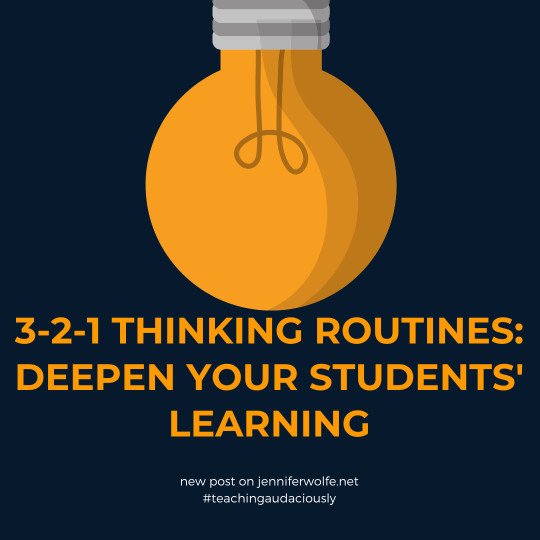
Teachers - this is an amazing, simple way to increase your student's thinking skills! 3-2-1 Thinking Routine http://bit.ly/32lznex
0 notes
Link

Check out some free lesson templates with my 3-2-1 thinking routine - and see how my Ss communicate with their penpals in Spain! 3-2-1 Thinking Routine http://bit.ly/32lznex
3-2-1 Thinking Routine
Thinking routines are "a broad and flexible framework for enriching classroom learning...and fostering students' intellectual development at the same time."
0 notes
Photo

Teachers - this is an amazing, simple way to increase your student's thinking skills! 3-2-1 Thinking Routine http://bit.ly/32lznex
0 notes
Link

Check out some free lesson templates with my 3-2-1 thinking routine - and see how my Ss communicate with their penpals in Spain! 3-2-1 Thinking Routine http://bit.ly/32lznex
3-2-1 Thinking Routine
Thinking routines are "a broad and flexible framework for enriching classroom learning...and fostering students' intellectual development at the same time."
0 notes